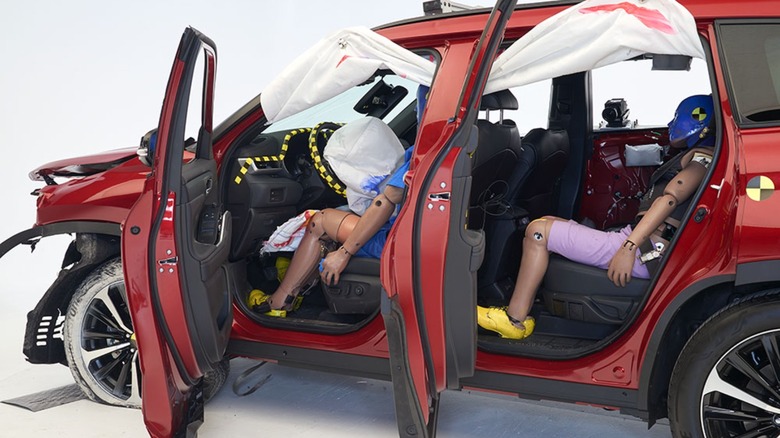This SUV Second-Row Crash Test May Change Your Mind On Which Family Car To Buy
Recent years have seen SUVs take over from station wagons and sedans as the vehicle of choice for a family. The justifications for this shift are numerous: SUVs are large, so they're more practical when it comes to hauling large loads and multiple people, even if that isn't always the case. More importantly, SUVs make their occupants feel safe, largely due to their commanding road presence and high ride height that allows for better visibility.
The Insurance Institute for Highway Safety has been carrying out vehicle crash tests to determine vehicle safety since the 1990s, and the institute recently updated its testing methodology to include what's called a "moderate overlap test" for rear passenger safety.
While crash test data has been used over the years to improve front passenger and driver safety, rear passenger safety has often gone by the wayside until this updated test. Of the 13 cars the IIHS tested, only four earned good ratings for rear passenger tests, despite all of them offering excellent front-seat protection.
One common issue that the rear passengers were likely to face in the vehicles that didn't score good ratings were "submarining," where the lap seat belt slides up into the abdomen instead of staying over the pelvis, potentially causing injury to the soft tissue and internal organs. Chest injuries from the seat belt, and potential head trauma from impacting the front seats were also found to be common in moderate and poor-rated vehicles.
Ford, Subaru, and Tesla proved the safest for rear passengers
The moderate overlap tests run by the IIHS tested a frontal collision with 40% of the front of the vehicle impacted. As the IIHS reports, in vehicles made after 2007, the tests showed that rear-seat passengers were 46% more likely to suffer fatal injury than the front seat passengers. This increased risk of injury is a direct result of a increase in front seat safety, rather than the rear seats becoming less safe.
Of the 13 mid-sized SUVs tested by the IIHS, only the Ford Explorer, Ford Mustang Mach-E, Subaru Ascent, and Tesla Model Y earned a good rating. A good rating is achieved when sensor reports don't exceed limits that would indicate "excessive risk of injury to the head, neck, chest, abdomen, or thigh." The restraint system must also prevent the passenger's head from impacting any of the vehicle's interior surfaces and coming too close to the back of the front seat.
Three of the rest of the test fleet — the Chevrolet Traverse, Toyota Highlander, and Volkswagen Atlas — scored moderate scores, while the rest scored poorly. The six vehicles with poor scores were the Honda Pilot, Hyundai Palisade, Jeep Grand Cherokee, Jeep Wrangler 4-door, Mazda CX-9, and Nissan Murano.
It's concerning that the vehicles that scored poorly are very popular cars for suburban families, and the tests were carried out with a small dummy that is meant to represent a 12-year-old child or a woman with a small frame.
